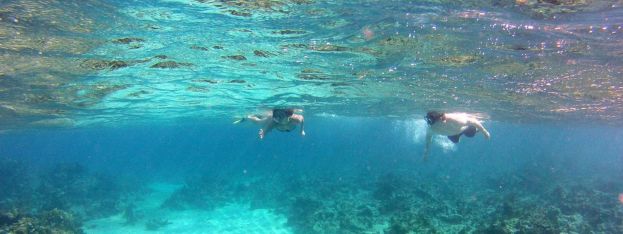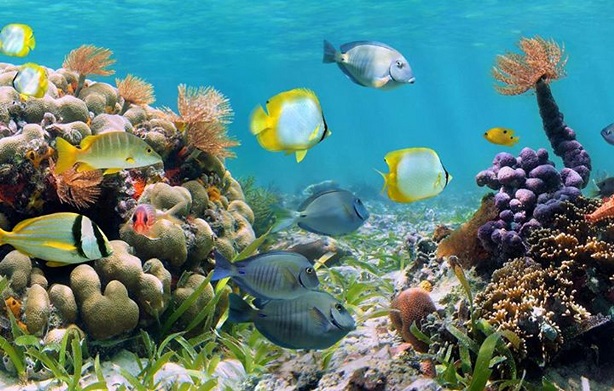
Best snorkeling spots in the Caribbean
Jan 18, 2019
Photo: In Jamaica and dubbed Gilligan’s Island by the locals, the turquoise water is rife with marine life and an old shipwrecked anchor and cannon.
By: Melanie Reffes
Source: USA Today
Unlike scuba diving, which requires more gear and more courage, snorkeling is a breeze for underwater sightseers. All it takes is a mask and a tube, a pair of fins, an inflatable life vest and a sense of adventure. Add snorkeling to sun, sand and sea and you’ll hear a whole lot of oohs and aahs courtesy of spectacular submerged landscapes, the occasional shipwreck and schools of crayon-colored tropical fish cavorting in clear calm water. Easy to master and too much fun not to try, floating near the surface of the water is so mesmerizing that it may become the focus of your island vacation.
Jamaica

Photo: A small island offshore from Negril in Jamaica, Booby Cay is also one of the best spots for snorkel newbies who might not be up to venturing into deeper waters.
A small island offshore from Negril, Booby Cay is also one of the best spots for snorkel newbies who might not be up to venturing into deeper waters. Dubbed Gilligan’s Island by the locals, the turquoise water is rife with marine life and an old shipwrecked anchor and cannon. Getting its name from the booby birds – the white and grey terns with blue feet – that return each year to lay their eggs, Booby Cay is where many scenes in the 1954 Disney classic “20,000 Leagues Under the Sea” were filmed. Local operators like JuJu Tours take the curious between the underwater caves for a look-see at the coral reefs and the rainbow-hued fish that mingle between them. Other snorkel hot spots include Port Royal in Kingston, where enchantingly colorful fish mingle with old shipwrecks; Doctor’s Cave Beach in Montego Bay Marine Park; Treasure Beach on the south coast; Runaway Bay in the parish of St. Ann, where you’ll find stingrays and sea urchins; and the picturesque reef at San San Beach on the outskirts of Port Antonio, where snorkelers meet and greet creatures great and small.
U.S. Virgin Islands

Photo: Donning snorkel gear, visitors comb the waters for hidden bottles of Cruzan Rum distilled next door in St. Croix.
A mecca for those who take their snorkeling seriously, Trunk Bay in St. John – the smallest of the three U.S. Virgin Islands – is a 673-foot-long self-guided snorkel trail with underwater signs noting the various species of coral and critters that play no deeper than 20 feet below the surface. Less touristy, Haulover North, on the east end of the small island, borders Virgin Islands National Park and is the top pick of snorkel-savvy locals. In St. Thomas, the largest of the Virgins, colorful fish and oddly shaped coral take a back seat to snorkeling in search of a bottle of Cruzan Rum. At the Bolongo Bay Beach Resort, the Snorkel Booze Hunt has been a wildly popular tradition every Thursday afternoon for three decades. Donning snorkel gear, visitors comb the waters for hidden bottles of Cruzan Rum (not airplane size, but big 200 mL bottles) distilled next door in St. Croix. The winners bring their bottle bounty to Iggies Beach Bar where bartenders mix it up.
Curacao

Photo: Easy to master and too much fun not to try, snorkeling is so mesmerizing that it may become the focus of your Caribbean vacation.
If you don”t count a few fishermen, an abandoned lighthouse and a few frond-covered sheds, Klein Curacao (or “Little Curacao” in English) is an empty island accessible with a 90-minute trip on a catamaran. What it lacks in amenities, it makes up in underwater sightseeing. Once a German naval base that was built in 1888, the windward side of the 1-mile-wide sliver is today a graveyard for boats that lost power and a watery wonderland of rainbow-hued fish and sea turtles. For the more adventurous, swim 10 minutes out to the reef and you’ll meet up with purple coral sandwiched between maize-colored plants, teensy striped fish and friendly eagle rays. Tours are available, like the nine-hour Bounty Adventures excursion that departs at 7:30 a.m. and includes breakfast and a barbecue buffet lunch.
Caracas Bay Peninsula is where you’ll find a pair of snorkeling spots called Tugboat and Director’s Bay that are well worth exploring. Moray eels and lobsters swim within the crevices of the wreck that sunk a quarter century ago while starfish lazily take five on the rocks. Explore on your own, book a tour at many of the island’s resorts or sign up for an Ocean Encounters underwater adventure.
Anguilla

Photo: Shoal Bay East, one of the longest beaches on the petite British island of Anguilla, is snorkel-ready with unruffled water and loads of underwater action courtesy of the wrasses, snappers and sea fans that live along the outer edge of the reef.
Shoal Bay East, one of the longest beaches on the petite British island, is snorkel-ready with unruffled water and loads of underwater action courtesy of the wrasses, snappers and sea fans that live along the outer edge of the reef. Gear can be rented at shacks on the sand or jump aboard Junior Fleming’s glass-bottom boat for a tour of the outer reefs. Sandy Hill Bay, on the windward side of the island, is rarely crowded, making it ideal for snorkelers who don’t covet a lot of human company. Protected by a long spit of coral, parrotfish, translucent tangs and gentle stingrays dart between the nooks and crannies. Accessible by boat or by scaling carefully down the cliff, Little Bay is well-worth the trek for quiet contemplation. And for those who like the Robinson Crusoe vibe, head to Sandy Island on Sunday when there’s a sunrise-to-sunset snorkel party fueled by frosty cups of rum punch (after you swim, of course) and giant buttery lobsters.
Bonaire

Photo: Island-wide, snorkelers can wade into the reef from the shoreline in front of many of the hotels to see a fireworks display of underwater color.
The reef-lined coast of Bonaire has received more awards for superb snorkeling than you can shake a fin at. From friendly angelfish and feisty sergeant majors to grunts, gobies and groupers, it’s a field day for snorkelers looking for action. On one of the most eco-astute islands in the Caribbean, Coral Restoration Foundation is a nonprofit volunteer group that builds and restores elkhorn and staghorn coral that have been damaged. Since it was founded in 2012, an impressive 9,000 coral fragments are growing in nurseries and over 8,000 have been transplanted. Island-wide, snorkelers can wade into the reef from the shoreline in front of many of the hotels to see a fireworks display of underwater color. To snorkel with the experts, Compass Bonaireand Woodwind Snorkeling take fans on sunset cruises and daytrips.
The Bahamas

Photo: One mile off the southern shore of Grand Bahama Island, the shallow bars and coral reefs at Peterson Cay National Park, one of the smallest national parks in the Bahamas, are among the best for catching a glimpse of sea fans, barracuda and manta rays that flit among the purple and yellow coral.
With 700 islands and cays fanning 100,000 square miles, snorkeling is sublime virtually anywhere in the Bahamas. Visibility is as deep as 100 feet and with water temperatures hovering near the 90-degree mark year-round, snorkeling is full of surprises just below the water’s surface. One mile off the southern shore of Grand Bahama Island, the shallow bars and coral reefs at Peterson Cay National Park, one of the smallest national parks in the Bahamas, are among the best for catching a glimpse of sea fans, barracuda and manta rays that flit among the purple and yellow coral. Also on Grand Bahama Island, Paradise Cove and Deadman”s Reef are home to an assortment of angelfish, parrotfish and squirrelfish, those curiously named small red fish with white stripes.
On Great Exuma Island, the long narrow sliver called Stocking Island is where you’ll see starfish resting in the aquamarine water. A tour like the Stocking Island Sea Escape offered by Island Routes is ideal for beachcombers and fans of perusing beneath the waves. After snorkeling, the beach beckons with collectible seashells that carpet the sand. A short hop by water taxi from the Treasure Cay Airport, Green Turtle Cay in the Abaco Islands is a sparkling barrier reef where dolphins live in the open water. Snorkel tours organized by Brendal’s Dive Center are a good bet for beginners and the more experienced.
Cayman Islands

Photo: Cheeseburger Reef – 150 yards offshore from the north edge of George Town in Grand Cayman – is teeming with sea turtles, snapper and butterfly fish swimming in 10 feet of water close to shore.
In Grand Cayman’s capital city of George Town, the Wreck of the Cali is eye-candy for kids who like to explore old freighters and the fish that live in the wreck. During the 1940s, the hull sprung a leak while carrying 30,000 bags of rice, which caused the rice inside to expand, blowing the boat in half. Today the freighter rests in shallow water close to shore where sea urchins, eels and octopus romp among the rusty ruins. Cheeseburger Reef – 150 yards offshore from the north edge of George Town – is teeming with sea turtles, snapper and butterfly fish swimming in 10 feet of water close to shore. With a sandy walk-in, it’s easy for snorkelers of all ages to frolic with the undersea critters who are seemingly not scared of their two-legged human admirers. Crazy busy with tourists but worth a visit, Stingray City in Grand Cayman is easy snorkeling along a shallow sandbar. People-friendly stingrays glide through the warm waters posing for snaps and foraging for food. A 15-minute walk from the cruise ship terminal and adjacent to Devil’s Grotto where marine creatures hide in the underwater tunnels, Don Foster’s Dive Cayman often operates a boat to Stingray City on Sundays. For those curious about secretive snorkeling sites, check out the less-touristy east end of Grand Cayman where the reefs host conch, sea fans, tarpon and lobster.
Antigua

Photo: On the opposite side of Antigua from the capital city of St. John”s, Cades Reef is a 2-mile-long barrier reef teeming with undersea marvels. Credit:
On the opposite side of the island from the capital city of St. John”s, Cades Reef is a 2-mile-long barrier reef teeming with undersea marvels. The show is spellbinding with pink-hued coral and brilliant blue and yellow fish that nuzzle the ocean floor. Reef sharks make periodic appearances; nurse sharks take shelter under the coral overhangs; and spiny lobsters, noisy parrotfish, slippery moral eels and agile barracuda also call the reef home. Super-easy for snorkelers to navigate, there is little or no current; water temperatures average 80 degrees Fahrenheit; and underwater visibility ranges from 50 to 140 feet. Explore on your own or book excursions like the Cades Reef Cruise offered by Tropical Adventures, Island Routes” “Sail and Snorkel” that includes lunch, and Cades Reef Tour with Treasure Island Cruises that adds a beachside barbecue to the snorkel mix.

